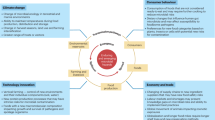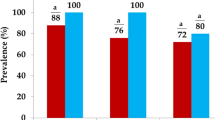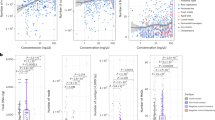Abstract
Accurate, sensitive and multiplexed detection of food-borne pathogens is crucial for assessing food safety risks. Here we present a digital DNA-amplification-free nucleic acid detection assay to achieve multiplexed and ultrasensitive detection of three food-borne pathogens. We used mesophilic Clostridium butyricum argonaute and magnetic beads in a digital carrier system (d-MAGIC). Clostridium butyricum argonaute, with its two-guide accurate cleavage activity, precisely targets and cleaves fluorescence-quencher reporters corresponding to different bacteria through a two-step process. The system uses fluorescence-encoded magnetic beads as programmable multi-probes, allowing the simultaneous detection of multiple pathogens and easy data interpretation via artificial intelligence. The method showed a wide detection range (101 to 107 CFU ml−1) and a low limit of detection of 6 CFU ml−1 for food-borne pathogens without DNA amplification. Digital nucleic acid testing using d-MAGIC can become a next-generation strategy for accurate and convenient pathogen detection.
This is a preview of subscription content, access via your institution
Access options
Access Nature and 54 other Nature Portfolio journals
Get Nature+, our best-value online-access subscription
$32.99 / 30 days
cancel any time
Subscribe to this journal
Receive 12 digital issues and online access to articles
$119.00 per year
only $9.92 per issue
Buy this article
- Purchase on SpringerLink
- Instant access to full article PDF
Prices may be subject to local taxes which are calculated during checkout






Similar content being viewed by others
Data availability
Source data are provided with this paper.
Code availability
The related code is available via GitHub at https://github.com/Wang-Qinyu/Panda/tree/main.
References
Food Safety (World Health Organization, 2023); https://www.who.int/health-topics/food-safety#tab=tab_1
Vikram, A., Callahan, M. T., Woolston, J. W., Sharma, M. & Sulakvelidze, A. Phage biocontrol for reducing bacterial foodborne pathogens in produce and other foods. Curr. Opin. Biotechnol. 78, 102805 (2022).
Tavelli, R., Callens, M., Grootaert, C., Abdallah, M. F. & Rajkovic, A. Foodborne pathogens in the plastisphere: can microplastics in the food chain threaten microbial food safety? Trends Food Sci. Technol. 129, 1–10 (2022).
Lee, H.-W. et al. Identification of microbial communities, with a focus on foodborne pathogens, during kimchi manufacturing process using culture-independent and -dependent analyses. LWT Food Sci. Technol. 81, 153–159 (2017).
Wei, C. et al. Recent progress on lateral flow immunoassays in foodborne pathogen detection. Food Biosci. 52, 102475 (2023).
Rantsiou, K. & Cocolin, L. in Advances in Microbial Food Safety (ed. Sofos, J.) Ch. 10 (Woodhead Publishing, 2013).
Lee, S. Y., Kim, J. H. & Oh, S. W. Combination of filtration and immunomagnetic separation based on real-time PCR to detect foodborne pathogens in fresh-cut apple. J. Microbiol. Methods 201, 106577 (2022).
Aslanzadeh, J. Preventing PCR amplification carryover contamination in a clinical laboratory. Ann. Clin. Lab. Sci. 34, 389–396 (2004).
Borst, A., Box, A. T. A. & Fluit, A. C. False-positive results and contamination in nucleic acid amplification assays: suggestions for a prevent and destroy strategy. Eur. J. Clin. Microbiol. Infect. Dis. 23, 289–299 (2004).
Rutty, G. N., Hopwood, A. & Tucker, V. The effectiveness of protective clothing in the reduction of potential DNA contamination of the scene of crime. Int. J. Legal Med. 117, 170–174 (2003).
Morono, Y. et al. Assessment of capacity to capture DNA aerosols by clean filters for molecular biology experiments. Microbes Environ. 33, 222–226 (2018).
Wu, H. et al. DropCRISPR: a LAMP-Cas12a based digital method for ultrasensitive detection of nucleic acid. Biosens. Bioelectron. 211, 114377 (2022).
Wu, X. et al. Digital CRISPR-based method for the rapid detection and absolute quantification of nucleic acids. Biomaterials 274, 120876 (2021).
Ali, Z., Mahas, A. & Mahfouz, M. CRISPR/Cas13 as a tool for RNA interference. Trends Plant Sci. 23, 374–378 (2018).
Kaminski, M. M., Abudayyeh, O. O., Gootenberg, J. S., Zhang, F. & Collins, J. J. CRISPR-based diagnostics. Nat. Med. 24, 702 (2018).
Xing, G. et al. Multiplexed detection of foodborne pathogens using one-pot CRISPR/Cas12a combined with recombinase aided amplification on a finger-actuated microfluidic biosensor. Biosens. Bioelectron. 220, 114885 (2023).
Leung, R. K. et al. CRISPR–Cas12-based nucleic acids detection systems. Methods 203, 276–281 (2022).
Chen, L., Ding, J., Yuan, H., Chen, C. & Li, Z. Deep-dLAMP: deep learning-enabled polydisperse emulsion-based digital loop-mediated isothermal amplification. Adv. Sci. 9, e2105450 (2022).
Xun, G. et al. Argonaute with stepwise endonuclease activity promotes specific and multiplex nucleic acid detection. Bioresour. Bioprocess 8, 46 (2021).
Kuzmenko, A. et al. DNA targeting and interference by a bacterial Argonaute nuclease. Nature 587, 632–637 (2020).
Yang, L. et al. Pyrococcus furiosus Argonaute combined with recombinase polymerase amplification for rapid and sensitive detection of Enterocytozoon hepatopenaei. J. Agric. Food Chem. 71, 944–951 (2023).
Liu, Q. et al. Argonaute integrated single-tube PCR system enables supersensitive detection of rare mutations. Nucleic Acids Res. 49, e75 (2021).
Ye, X. et al. Argonaute-integrated isothermal amplification for rapid, portable, multiplex detection of SARS-CoV-2 and influenza viruses. Biosens. Bioelectron. 207, 114169 (2022).
Song, J. et al. Highly specific enrichment of rare nucleic acid fractions using Thermus thermophilus Argonaute with applications in cancer diagnostics. Nucleic Acids Res. 48, e19 (2020).
Wang, Y. et al. In vitro Argonaute cleavage-mediated quantitative PCR facilitates versatile CRISPR/Cas-induced mutant analysis. Sens. Actuators B 374, 132781 (2023).
Kuzmenko, A., Yudin, D., Ryazansky, S., Kulbachinskiy, A. & Aravin, A. A. Programmable DNA cleavage by Ago nucleases from mesophilic bacteria Clostridium butyricum and Limnothrix rosea. Nucleic Acids Res. 47, 5822–5836 (2019).
Vaiskunaite, R., Vainauskas, J., Morris, J. J. L., Potapov, V. & Bitinaite, J. Programmable cleavage of linear double-stranded DNA by combined action of Argonaute CbAgo from Clostridium butyricum and nuclease deficient RecBC helicase from E. coli. Nucleic Acids Res. 50, 4616–4629 (2022).
Hegge, J. W. et al. DNA-guided DNA cleavage at moderate temperatures by Clostridium butyricum Argonaute. Nucleic Acids Res. 47, 5809–5821 (2019).
Wang, Z. et al. Mesophilic Argonaute-mediated polydisperse droplet biosensor for amplification-free, one-pot, and multiplexed nucleic acid detection using deep learning. Anal. Chem. 96, 2068–2077 (2024).
Hafiz, M. et al. Magnetic nanoparticles draw solution for forward osmosis: current status and future challenges in wastewater treatment. J. Environ. Chem. Eng. 10, 108955 (2022).
Chavan, N., Dharmaraj, D., Sarap, S. & Surve, C. Magnetic nanoparticles—a new era innanotechnology. J. Drug Deliv. Sci. Technol. 77, 103899 (2022).
Binandeh, M. Performance of unique magnetic nanoparticles in biomedicine. Eur. J. Med. Chem. Rep. 6, 100072 (2022).
Fu, C. et al. Horseradish peroxidase-repeat assay based on tyramine signal amplification for highly sensitive H2O2 detection by surface-enhanced Raman scattering. Analyst 146, 7320–7326 (2021).
Chen, Q. et al. A highly-sensitive colorimetric assay method for antibody array based on an tyramide signal amplification system. Anal. Lett. 45, 219–226 (2012).
Gombolay, G. Y. et al. Review of machine learning and artificial intelligence (ML/AI) for the pediatric neurologist. Pediatr. Neurol. 141, 42–51 (2023).
Moon, G. et al. Machine learning-based design of meta-plasmonic biosensors with negative index metamaterials. Biosens. Bioelectron. 164, 112335 (2020).
Wang, S. K. et al. Single-cell multiome of the human retina and deep learning nominate causal variants in complex eye diseases. Cell Genom. 2, 100164 (2022).
Long, E. et al. The case for increasing diversity in tissue-based functional genomics datasets to understand human disease susceptibility. Nat. Commun. 13, 2907 (2022).
Shameer, K., Tripathi, L. P., Kalari, K. R., Dudley, J. T. & Sowdhamini, R. Interpreting functional effects of coding variants: challenges in proteome-scale prediction, annotation and assessment. Brief Bioinform. 17, 841–862 (2016).
Zander, A. et al. Guide-independent DNA cleavage by archaeal Argonaute from Methanocaldococcus jannaschii. Nat. Microbiol. 2, 17034 (2017).
Swarts, D. C. et al. Autonomous generation and loading of DNA guides by bacterial Argonaute. Mol. Cell 65, 985–998.e6 (2017).
Zhao, J. et al. A machine vision-assisted Argonaute-mediated fluorescence biosensor for the detection of viable Salmonella in food without convoluted DNA extraction and amplification procedures. J. Hazard. Mater. 466, 133648 (2024).
Hou, Y., Chen, S., Zheng, Y., Zheng, X. & Lin, J.-M. Droplet-based digital PCR (ddPCR) and its applications. Trac. Trends Anal. Chem. 158, 116897 (2023).
Cretich, M., Daaboul, G. G., Sola, L., Unlu, M. S. & Chiari, M. Digital detection of biomarkers assisted by nanoparticles: application to diagnostics. Trends Biotechnol. 33, 343–351 (2015).
Xiang, X., Shang, Y., Zhang, J., Ding, Y. & Wu, Q. Advances in improvement strategies of digital nucleic acid amplification for pathogen detection. Trac. Trends Anal. Chem. 149, 116568 (2022).
von Wasielewski, R. et al. Tyramine amplification technique in routine immunohistochemistry. J. Histochem. Cytochem. 45, 1455–1459 (1997).
Stack, E. C., Wang, C., Roman, K. A. & Hoyt, C. C. Multiplexed immunohistochemistry, imaging, and quantitation: a review, with an assessment of tyramide signal amplification, multispectral imaging and multiplex analysis. Methods 70, 46–58 (2014).
Acknowledgements
We thank the National Natural Science Foundation of China (32172293), the National Key Research and Development Program of China (2022YFF0607900) and the Open Project of Key Laboratory of Detection Technology of Focus Chemical Hazards in Animal-Derived Food for State Market Regulation (number KF-202201) for financial support.
Author information
Authors and Affiliations
Contributions
Z.W. and Y.C. conceptualized the research. Z.W. and X.C. planned and performed the research. Z.W. assisted in testing the code. Z.W. analysed the data. Z.W. wrote the original draft. A.M., F.J. and Y.C. reviewed and edited the paper.
Corresponding author
Ethics declarations
Competing interests
The authors declare no competing interests.
Peer review
Peer review information
Nature Food thanks Seyed Mohammad Taghi Gharibzahedi, Sang-Soon Kim and Fengge Song for their contribution to the peer review of this work.
Additional information
Publisher’s note Springer Nature remains neutral with regard to jurisdictional claims in published maps and institutional affiliations.
Supplementary information
Supplementary Information
Supplementary Figs. 1–9, Tables 1–7, Methods and information for the Results section.
Source data
Source Data Fig. 2
Unprocessed gels (Fig. 2c) and statistical source data.
Source Data Fig. 3
Statistical source data.
Source Data Fig. 4
Statistical source data.
Source Data Fig. 5
Statistical source data.
Source Data Fig. 6
Statistical source data.
Rights and permissions
Springer Nature or its licensor (e.g. a society or other partner) holds exclusive rights to this article under a publishing agreement with the author(s) or other rightsholder(s); author self-archiving of the accepted manuscript version of this article is solely governed by the terms of such publishing agreement and applicable law.
About this article
Cite this article
Wang, Z., Cheng, X., Ma, A. et al. Multiplexed food-borne pathogen detection using an argonaute-mediated digital sensor based on a magnetic-bead-assisted imaging transcoding system. Nat Food 6, 170–181 (2025). https://doi.org/10.1038/s43016-024-01082-y
Received:
Accepted:
Published:
Issue date:
DOI: https://doi.org/10.1038/s43016-024-01082-y
This article is cited by
-
DNAzyme-driven dual-cycle coupled with pregnancy test strip signal transduction for monitoring of Dreissena polymorpha
Microchimica Acta (2025)
-
Nanoparticles-based electrochemical sensing platform for high-through immunoassay with redox-activity CaCO3 nanotags on a magnetic microfluidic device
Microchimica Acta (2025)
-
Smart and Sustainable Microplastic Removal: Hybrid Systems, Bio-Inspired Technologies, Real-Time Sensing, and Policy Integration
Water, Air, & Soil Pollution (2025)



